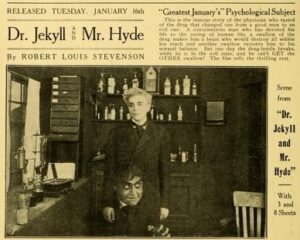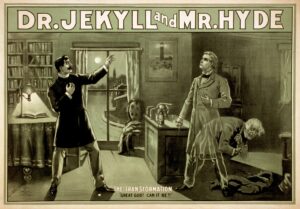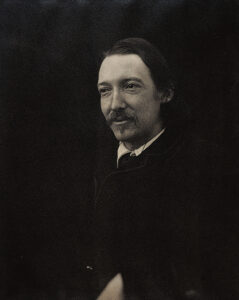
Robert Louis Stevenson had first read a paper in a French scientific journal about sub-consciousness, and this is believed to be the first source of where he got his inspiration to write Dr. Jekyll and Mr. Hyde. He then co-wrote a play about a town councilor who became a secret criminal at nighttime. This led to his famous novella. What is interesting is that Robert Louis Stevenson claims he had actually never heard of a case of a person with multiple personalities before writing his book. This information seems untruthful. There have been several case studies about people with multiple personalities, including a soldier who established two different personalities after his left cerebral hemisphere was impaired by a gunshot wound. The theory of the double brain is the concept that is portrayed throughout Jekyll and Hyde and is most likely the main scientific component for Stevenson’s inspiration. Multiple personalities were only a concept of discussion in the time that Robertson wrote his novella, not a clinical problem yet.
TWO BRAINS?
The dual brain theory was discussed throughout the nineteenth century postulated that there are actually two independent brains that function in different ways. The left hemisphere was associated with masculinity, reason and linguistic ability while the right brain was considered the feminine aspect of emotions, instincts, and the unconscious. Hyde resembles the right part of the brain: madness, emotion, femininity, and animalistic. Victorian scientists often argue that dual or multiple personality disorders, or other forms of insanity, resulted from an over-enlarged right brain overpowering the rational activities of the left-brain. The right hemisphere only dominated the brains of women, savages, children, criminals and the insane. Jekyll and Hyde creates the idea that the brain sometimes doesn’t only have one dominant side. In this case, Jekyll uses much of his left hemisphere and then changes to the right hemisphere dramatically, which creates asymmetry that indicates corruption and mental illness.
Since the dual-brain theory suggests that two brains work individually for balance, this questions whether people were not simply whole beings, but balancing pieces between two opposing natures in a being.
“…even if I could rightly be said to be either, it was only because I was radically both;”
But if the mind during this era was understood at the time to be a balance between both rational and irrational, what was Stevenson’s view on Dr. Jekyll? It’s possibly a very severe imbalance with the “two brains”. There is a clear distinction of appearance and actions between Dr. Jekyll and Mr. Hyde. The link between the explanation of mental disorder in the Victorian Era and the dissimilarity between Jekyll and Hyde’s identities is apparent.
Stiles talks about two patients in specific that have dual or multiple personality disorder, Félida X. and Segeant F. Félida X. is compared to Jekyll in her “young, light and happy” personality. A similarity between Jekyll and the two patients is the way their personalities transform. Félida X. experiences sharp pains and becomes unconscious before she turns to another state. Sergeant F. experiences uneasiness and a dull pain in the head. As Jekyll takes the powder and transforms into Hyde, his symptoms are as said in the novella:
“a qualm…a horrid nausea and the most deadly shuddering. These passed away, and left me faint”.
Sergeant F.’s second personality resembles Hyde because he has animalistic, abnormal qualities. Stevenson decides not to use a woman as the protagonist because it makes the story more edgy. Hyde is a violent, sexual predator, rather than a weak, fallen woman.
There are fascinating connections between the fictional Jekyll and Hyde and Proctor’s scientific case studies. Stevenson also purposely makes a male protagonist to create an irony, because apparently in the middle of the nineteenth century, a majority of psychiatric patients in asylums were women. This was a century where the “madness” or “crazy” side of the brain was feminine, and the side of the brain that had reason and understanding was considered masculine. The Strange Case of Dr. Jekyll and Mr. Hyde can be read as a critique of some of the nineteenth century’s most respected assumptions about the diagnosis and grouping of medical subjects.
STRANGE CASES

When reading the title The Strange Case of Dr. Jekyll and Mr. Hyde, the words “strange case” gives the audience an impression that what they are reading is a scientific case study. Jekyll and Hyde is considered a Gothic case study. An analyst suggests that Gothic “horror fiction has a generic obligation to evoke fear or suggest mystery,” whereas “science… attempts to contain fear and offer a rational explanation for all phenomena.” Stiles briefly compares Jekyll and Hyde to a few other gothic writes, including Mary Shelley’s Frankenstein. I have found that there are actually a few similarities between Frankenstein and Jekyll and Hyde. As an addition to their gothic themes, the stories are essentially quite similar in themselves when you think about it. Both main characters are scientists who have a thirst for knowledge and are willing to exceed human limitations. While both Frankenstein and Jekyll had strong curiosity, their initial reactions to their discoveries were different. Frankenstein’s reaction was the abandonment and disgust of the creature he produced, and Jekyll was so intrigued with his potion that he had to see how far he could take this experiment. Both stories ended in many deaths and the inevitable destruction of the protagonists.
“WHICH BRAIN ARE YOU?’

Reading this article shows me a better understanding of the scientific theories back then. I can see how sexism did play a big role. Women were known to be empathetic while men were known to be analytical. Today, there are still theories out there that the two sides of the brain work differently, although gender isn’t really involved. Now, people would just wonder what type of person they are according to which side of the brain they use dominantly. Have you ever heard that left-brained people are more logical and analytical while right-brained people are creative and artistic? Even I am guilty of taking an online quiz on Buzzfeed or some other social media website to discover if I am “right-brained” or “left-brained”. While the two sides of the brain do work differently in some ways, research now would say that someone’s personality doesn’t depend on the functions of the two sides of the brain. All humans use their entire brain equally.
Discussion Questions:
Do you think the novella suffers without any female characters? What would be different about a female protagonist?
What are your thoughts on the dual-brain theory in the Victorian Era, compared to theories about the brain today?
After learning about the dual-brain theory, do you see a different meaning in Dr. Jekyll and Mr. Hyde? Why or why not?
Sources
“Why the Left-Brain Right-Brain Myth Will Probably Never Die.” Psychology Today, Sussex Publishers, www.psychologytoday.com/us/blog/brain-myths/201206/why-the-left-brain-right-brain-myth-will-probably-never-die.
Stevenson, Robert Louis. The Strange Case of Dr. Jekyll and Mr. Hyde.
Wanjek, Christopher. “Left Brain vs. Right: It’s a Myth, Research Finds.” LiveScience, Purch, 3 Sept. 2013, www.livescience.com/39373-left-brain-right-brain-myth.html.








